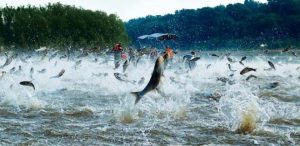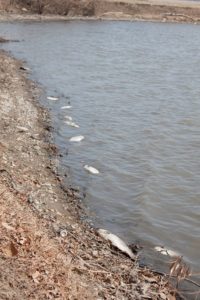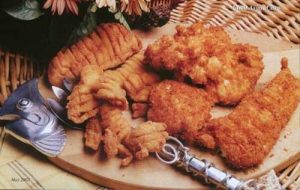Published on April 12, 2016
A Flying Fish Frenzy
 Fishing trips in the Midwest are typically associated with tranquil waters and relaxing, daylong excursions. But more and more often, horror stories are being told about unsuspecting boaters and fishermen who have been attacked aboard their vessels by armies of oversized fish that are forcefully hurling themselves up out of the water. These flying, giant fish are known as Asian carp (Cyprinidae family). They can grow to be five feet in length, weigh up to 110 pounds, and unless action is taken soon, those individuals daring enough to brave the waters will just have to accept helmets as a part of their regular river garb.
Fishing trips in the Midwest are typically associated with tranquil waters and relaxing, daylong excursions. But more and more often, horror stories are being told about unsuspecting boaters and fishermen who have been attacked aboard their vessels by armies of oversized fish that are forcefully hurling themselves up out of the water. These flying, giant fish are known as Asian carp (Cyprinidae family). They can grow to be five feet in length, weigh up to 110 pounds, and unless action is taken soon, those individuals daring enough to brave the waters will just have to accept helmets as a part of their regular river garb.
Originally native to the Yangtze River in southeastern China, “Asian carp” collectively refers to bighead (Hypophthalmichthys nobilis), black (Mylopharyngodon piceus), grass (Ctenopharyngodon idella), and silver (Hypophthalmichthys molitrix) carp varieties. In the 1960s and 70s, fish farmers in Arkansas first imported Asian carp in order to remove algal growth from commercial ponds. When flood waters overtook these fisheries, the imported carp escaped into the Mississippi River. Without any natural predators, the carp have flourished, outcompeting native fish throughout the Mississippi, Missouri, and Illinois River systems. Consequently, these fish are now considered to be an invasive species in the United States. The continued dominance of an invasive species, such as the Asian carp, in regional waterways has a negative impact on native riverine ecosystems as well as the fishing industry. However, harvesting these pesky fish for food or for fertilizer could offer a practical solution to the carp conundrum at hand.
Exponential Growth & Collateral Ecological Damage
Unfortunately, Asian carp are continuing to thrive in the Mississippi and Missouri watersheds. These river systems provide ideal conditions for Asian carp to effectively develop and reproduce—just one female is capable of laying a staggering two million eggs at a time! Juveniles rapidly reach reproductive maturity and, with no natural predators in the U.S, the population is currently growing at an exponential rate. The carp are dominating regional waterways both in abundance and in biomass, crowding out a multitude of native fish species.
In addition to being exceptionally good at reproducing, these carp species are especially good at leaping up out of the water. With a capacity to propel themselves at least ten feet out of the water, Asian carp have been known to bypass many physical barricades implemented by humans. Because of this, limiting the expansion of this aggressive invader has proven to be quite difficult.
As the carp population continues to increase and expand its range, more damage is being done to the environment, especially in terms of ecology. According to the Conservation Federation of Missouri, several of the Asian carp species degrade river ecosystems by outcompeting native fish for food and by destroying valuable habitat. The National Park Service indicates that Asian carp are known to be voracious filter feeders. Some species eat up to twenty percent of their body weight every day, while others are known to eat up to a whopping forty percent a day!
Many of these invasive fish primarily feed on plankton, which is a food source that many native mussels and smaller fish such as ciscoes (Coregonus artedi) and yellow perch (Perca flavescens) rely on to survive. When the populations of these smaller organisms decline, the populations of the larger native fish that feed on them, such as the channel catfish (Ictalurus punctatus) and walleye (Sander vitreus), also decline. For example, recent studies have illustrated a correlation with increasing carp populations and decreasing body masses of such native fish as bigmouth buffalo (Ictiobus cyprinellus) which feed primarily on these smaller fish species. This result suggests that the carp are starving the other fish by direct competition for the same food source.
Additionally, other species of Asian carp feed mainly on aquatic plants. According to the National Park Service, these fish are capable of drastically altering river and shoreline vegetation, primarily by uprooting and overconsuming plants and degrading water quality. Many of the plants they feed on provide important spawning and nursery habitats for native fish. Increased turbidity or cloudiness as a result of displaced aquatic sediment also covers eggs and makes it difficult for native species to find food.
With continued habitat degradation, the overall abundance of native fish will eventually decline. As a result, the biodiversity of these waterways will also decrease and the food web will become increasingly unbalanced. If left unchecked for too long, the Asian carp will effectively decimate nearly all of the native fish populations in the Mississippi and Missouri River systems.
A Slippery Situation – Carp’s Impact on the Fishing Industry
The Midwest has long been a prevalent freshwater fishing region. In fact, Missouri is frequently considered to be one of the top ten fishing destinations in the U.S. However, as Asian carp populations increase, popular native river game fish, such as catfish, trout, buffalo, and bluegill, decrease. The vast majority of the freshwater fishing industry relies on these sought-after native varieties to sell on the market and to recreational fishers. There is even some evidence to suggest that the invasive carp have displaced and deteriorated stocks of non-invasive, five-pound bigmouth buffalo that some fisherman recount catching and selling for nearly thirty years. Since the invasion is currently spreading farther north along the Mississippi (carp have been spotted in Chicago), many fear the invaders will next wreak havoc in the Great Lakes.
An estimated 1.5 million jobs and over sixty billion dollars in annual wages in tourism and recreation are provided by the Great Lakes. If carp were to establish a self-sustaining population within the Great Lakes, current commercial and sportfish populations would be greatly diminished. It would be a hard hit to a nearly seven-billion-dollar-a-year industry that relies on commercial, tribal, and sport fisheries. But even if the carp do not enter the Great Lakes, the U.S. Geological Survey (USGS) estimates they could still drastically affect freshwater fisheries in as many as 31 states.
Cashing in on Carp
 Despite being the source of so much negativity, the Asian carp invasion could be a potential gold mine for fishermen. Just consider the abundance of these fish. In some waterways, the Missouri Department of Conservation believes the carp make up nearly 95 percent of total biomass in the water. And for the most part, these fish are relatively easy to catch—many are literally jumping into boats! In recent years, the Illinois Department of Natural Resources estimated that Asian carp made up 82 percent of the commercial catch on the Illinois River and 30 percent on the Mississippi.
Despite being the source of so much negativity, the Asian carp invasion could be a potential gold mine for fishermen. Just consider the abundance of these fish. In some waterways, the Missouri Department of Conservation believes the carp make up nearly 95 percent of total biomass in the water. And for the most part, these fish are relatively easy to catch—many are literally jumping into boats! In recent years, the Illinois Department of Natural Resources estimated that Asian carp made up 82 percent of the commercial catch on the Illinois River and 30 percent on the Mississippi.
Aaron Templemire, a Boonville, Missouri, business owner with a commercial fishing license, specifically harvests Asian carp to sell at a local market. “The reason,” he says, “is because any time a non-native animal comes to dominate systems as large as the Mississippi and lower Missouri Rivers, especially in biomass, there are going to be some [major] consequences. In my experience, at least 95% of my catches [on the Missouri River] are made up of silver or bighead Asian carp varieties.”
Astonishingly, there is even an international market for Asian carp. Even though the Asian carp once originated from the Yangtze River, they have since been overfished to the point that Chinese scientists have contacted the Missouri Department of Conservation to ask for help in repopulating their waterways. Considered a delicacy in China, the carp remain highly sought after commercially in that country. In fact, one commercial carp processing plant in Illinois has a contract to export thirty million pounds of invasive carp to Chinese consumers.
In essence, by fishing specifically for the invasive carp, the economy can get a much needed boost, the troublesome carp population can be controlled, and the native ecosystems can recover. Harvested carp could also serve as a cheaper food source for those suffering from food shortages around the globe. Seems like a win-win for everyone involved, except maybe the carp.
Coming to a Food Place Near You (Maybe)
Dr. Mark Morgan, associate professor at the University of Missouri – Columbia (MU) School of Natural Resources, is leading a movement to bring these invasive carp to Midwestern dinner tables. One of his ongoing projects focuses on making the prospect of dining on Asian carp more palatable to American consumers. His goal is to connect local restaurants with regional carp processing plants, such as the one in Illinois, to promote recreational carp fishing, and to ultimately control the overwhelming population of invasive carp.
In Columbia, Missouri, the Eat MO Carp Project has already been successful in getting Asian carp on the shelves of at least one local grocery store and on the menu at a number of local restaurants. According to a Scientific American article written by Tim Wall, an MU graduate student and member of the Eat MO Carp Project, Moser’s Discount Foods currently sells minced carp meat, fish heads, and fillets at its Columbia location. La Siesta Mexican restaurant and China Garden each respectively offered temporary entrées of carp chorizo and carp pot stickers. This past summer, Broadway Brewery also introduced a seasonal menu featuring a number of carp dishes. Even MU Campus Dining Services introduced Asian carp meals in dining halls and in the student center.
Changing the Way We See Carp – It’s C-A-R-P, Not C-R-A-P!
Carp is amongst the most widely consumed fish in the world—even considered a delicacy in many Asian cultures—yet, Asian carp have a bad reputation amongst Americans. This is partly because many confuse the invasive Asian carp species with the non-invasive, bottom-feeding common carp that are not used as food.
In Templemire’s business experience, he has found that the majority of people have not tried carp, in part, because the United States simply lacks the cultural acceptance of feeding on these fish. He adds, “When I mention adding fish to a soup, most people I know immediately respond, ‘Woah, what? Who would put fish in a soup?’ It’s definitely a cultural thing.”
This species is also commonly found in heavily sedimented, dirty-looking waters. Therefore, people might associate the carp with these seemingly filthy, undesirable conditions. Interestingly enough, however, in comparison with many of the native fish species found in the same waters, Asian carp are significantly more tolerant to a number of water quality issues.
While the thought of consuming a polluted fish might be a turn off for most people, if prepared properly it is safe and most consumers do not notice a difference between it and other fish. In February of 2015, researchers at the University of Missouri conducted a blind taste test utilizing despised Asian carp and prized catfish. This study demonstrated that Asian carp could be widely considered to taste as good as or even better than commonly consumed species.
As the popularity of carp increases, more and more recipes are surfacing for appealing ways to prepare carp meat. When fried, the flesh turns a flaky snow white color comparable to that of cod. Another popular method found in some grocers is minced or ground carp. Surprisingly, many carp consumers describe the ground form of carp to be somewhat similar in taste to ground turkey. And in most cases, the carp is cheaper and healthier than ground beef. In fact, if caught recreationally, this might even be a free meal! Carp are also known to be high in beneficial omega 3 fatty acids while still being low in overall fat content.
ground beef. In fact, if caught recreationally, this might even be a free meal! Carp are also known to be high in beneficial omega 3 fatty acids while still being low in overall fat content.
In order to present Asian carp in a more positive light, Templemire suggests, “[We] market [the carp] as a fresh, wild caught, and environmentally friendly food. Also, provide customers with some of the Asian recipes that have been used with this fish for hundreds of years. It is a guilt free fish—the ultimate in sustainability. Forget about depleting stocks of wild fish in the oceans. I am talking about a fish that when people eat it, they provide an environmental service. Another option is to process it into something else. And this is being done already—either in an edible form like carp chili or non-edible forms such as fertilizer.”
Cropping with Carp
Until Asian carp consumption becomes more mainstream, local demand for them as a food source will likely remain relatively low. In order to offset this low demand for commercially fished Asian carp, many states are offering subsidies, and many small companies are instead promoting the use of carp in non-food products, such as fertilizers, fish meal, and fish oil.
Native Americans used fish as effective natural fertilizers for hundreds of years. As the fish decompose, they return various beneficial nutrients, such as nitrogen, to the soil. This could potentially boost crop yield and overall economic gain in the agriculture industry. Plus, fish emulsion is somewhat similar to composting: it is relatively easy and anyone can benefit from it!
Carpe Diem or Carpe Eat’em?
In the end, whether individuals choose to eat the carp or apply them to food crops, it is evident that the invasive Asian carp must go. Harvesting these pesky fish would offer a practical solution to several of the ecological and economic troubles plaguing the Mississippi and Missouri River regions due to the influx of these unwanted residents. Even though the Asian carp population may never be completely eradicated, just small adjustments in local consumption habits have the potential to bring much needed relief to affected river environments in the region.
Solutions to environmental problems are rarely presented on silver platters, but in this case, the solution can quite literally be served a la carte. Consumers, particularly those in the Midwest, have the ability to combat the Asian carp invasion with such sophisticated tools as the forks and knives found in their kitchen drawers. These individuals just have to decide whether or not they will Carpe Diem to Carpe Eat’em.